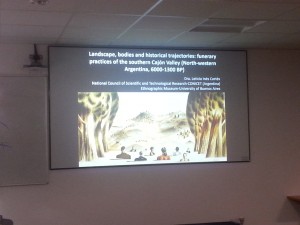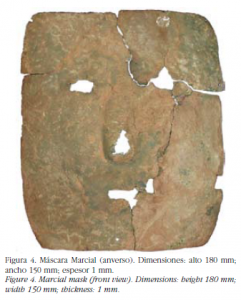 On Friday 9th October we were treated to the second instalment of the departmental research seminar series here in archaeology. Continuing the funerary theme of last week, Dr. Leticia Cortés from CONICET-U/ Buenos Aires delivered a presentation on her PhD research topic: “Landscape, bodies and historical trajectories: funerary practices of the southern Cajón Valley (North-western Argentina, 6000-1300 BP). The sites studied in the presentation were two villages, Cardonal and Bordo Marcial, dated to circa 2000BP. Burials in the area are found in tombs and cemeteries that span from 6000BP to 1300BP. The burials pre- and post-date the settlement occupations, but there are contemporary internments also.
On Friday 9th October we were treated to the second instalment of the departmental research seminar series here in archaeology. Continuing the funerary theme of last week, Dr. Leticia Cortés from CONICET-U/ Buenos Aires delivered a presentation on her PhD research topic: “Landscape, bodies and historical trajectories: funerary practices of the southern Cajón Valley (North-western Argentina, 6000-1300 BP). The sites studied in the presentation were two villages, Cardonal and Bordo Marcial, dated to circa 2000BP. Burials in the area are found in tombs and cemeteries that span from 6000BP to 1300BP. The burials pre- and post-date the settlement occupations, but there are contemporary internments also.
Studying the archaeology of burial can be considered difficult in this region. Dr. Cortés highlighted that archaeologists in the late 19th and early 20th centuries targeted tombs and cemeteries for visually pleasing artefacts and in so doing comingled the then less-significant human bone. The two case studies that she then presented were from recent excavations of burials that were undisturbed by past archaeologists, a rarity in this region.
The first case study that was described was a tomb (c. 3000BP) that contained at least 14 co-mingled individuals. These individuals were possibly wrapped in material that then degraded, causing the mixing of elements. It is also possible that the tomb was later intentionally reopened and select body parts removed. One of the most exciting finds from this tomb was an anthropomorphic copper mask, which is one of the oldest intentionally shaped copper objects in the Andes.
The second case study was that of a sand dune cemetery. This hot, bright, visible point in the landscape is separated from the settlements by water courses that must be crossed to reach the cemetery. It yielded a thankfully undisturbed burial that had to be excavated as the individual was eroding out of the sand dune. The body was in a tight crouched position, again suggesting that they had been wrapped before internment. The position and characteristics of the sand dunes are reflected in modern Andean associations of the afterlife – that it is a place of heat that one must cross water to get to.
Dr. Cortés analysed these burials from so many perspectives – the people who were interned, the individuals who came back to reopen the graves, the archaeologists of the late 19th and early 20th centuries and finally the people and archaeologists who use the landscape today – that it was possible to imagine a complete picture of these burials in the landscape from their creation. We would like to thank Dr. Cortés for such an interesting presentation; if you would like to find out more about her and her research you can visit her academia page.
Sources:
Scattolin, M. C., Bugliani, M. F., Cortés, L. I., Pereyra Domingorena, L., & Calo, M. (2010). UNA MÁSCARA DE COBRE DE TRES MIL AÑOS: ESTUDIOS ARQUEOMETALÚRGICOS Y COMPARACIONES REGIONALES.Boletín del Museo Chileno de Arte Precolombino, 15(1), 25-46.
Written by Emily Johnson.

